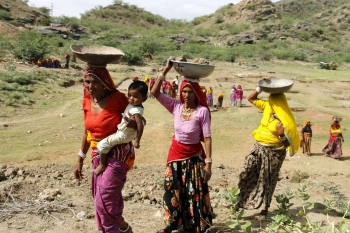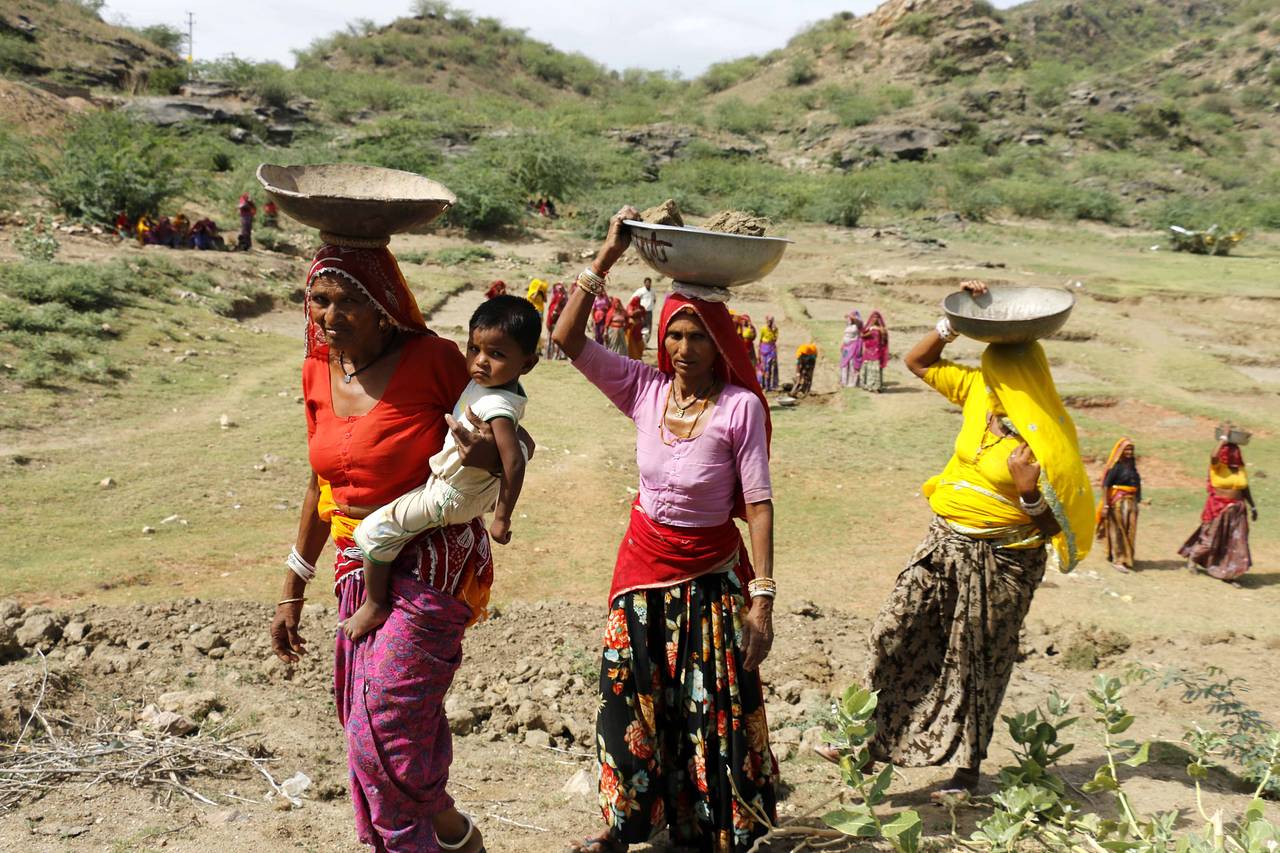
.jpg) Adv Jessy Kurian
Adv Jessy Kurian

Though women represent 49% of India’s population, they contribute only 18% of its economic output, about half the global average. The percentage of working age of women who are economically active in the country is far lower than the global average.
At present, women’s workforce in our country is 20.3%; it is 18.2% in urban India. As per the statistics available, women’s employability is 51.44 % in 2022 compared to 41.25% in 2021. The female labour force has continued to fall over the last three decades.
India’s female labour force -- the share of working-age women who report either being employed, or being available for work -- has fallen to a historic low of 23.3% in 2017-18; it means that three out of four women over the age of 15 in India are neither working nor seeking work. This would imply that they are most likely running the house and taking care of children. Recent data confirm that just nine countries around the world, including Syria and Iraq, have a fewer proportion of working women than India.
Between 2017 and 2022, the overall labour participation rate dropped from 46% to 40%. Among women, the data is even starker. About 21million disappeared from the workforce, leaving only 9% of the eligible population employed or looking for positions, according to the Centre for Monitoring Indian Economy (CMIE).
“The large share of discouraged workers suggests that India is unlikely to reap the dividend that its young population has to offer,” said Kunal Kundu, an economist with Societe Generale GSC Pvt in Bengaluru. “India will likely remain in a middle income trap, with the K-shaped growth path further fueling inequality.”
Women Labour Force
There are many reasons for the women to drop out of labour force and they are given below:
Covid-19
Covid-19 pandemic has come as a shock, resulting in massive job losses for women, especially informal workers, and slower recovery of women-led microbusinesses. It has also increased domestic work, deepened gender digital divides, disrupted girl’s schooling and placed millions of female health workers at risk.
According to World Bank, in 2021, India had one of the lowest female labor force participation rates in the world. The percentage of women in the labour force had fallen to a record low of 15.5% during April-June 2020 quarter, when India imposed strict lockdown to curb the spread of Covid-19 virus, said the report, released by the Ministry of Statistics.
According to a Research conducted by Mitali Nikore, Covid-19 has only exacerbated these trends. Women faced the brunt of initial lockdown. During March-April 2020, 26.6% of female workforce moved out of labour force, while 13.4% of men moved out during the same period.
Occupational segregation
Between 1977 and 2017, India’s economy witnessed a surge in the contribution of services to GDP. The proportion of rural men employed in agriculture fell from 80.6% to 53.2%, but rural women decreased from 88.1% to 71.7% (NSSO data). Between 1994-2010, women received less than 19% of new employment opportunities generated in India’s 10 fastest growing occupations.
Increased mechanization
In agriculture, as the use of seed drillers, harvesters, threshers and husking equipment increased, men displaced women. In textiles, power looms, button stitching machines, and textile machinery phased out women’s labour. Nearly 12 million women in India could lose their jobs by 2030 owning to automation, according to a McKinsey Global Institute report.
Social norms
Unpaid care work continues to be a woman’s responsibility, with women spending on average five hours per day on domestic work, vs 30 minutes for men (NSSO, 2019). Women face inordinate mobility restrictions such that only 54% women can go to a nearby market alone (NFHS, 2015-16). Women regularly sacrifice wages, career progression, and education opportunities to meet family responsibilities, safety considerations and other restrictions.
Marriage and restrictions
Even employed women, after marriage, are prohibited by husbands or members of the matrimonial home from continuing their employment. In some cases, marriage takes place on the promise of permitting the girl to continue her employment, but they later take a U-turn. Thus, women become home-makers against their dream. Even well educated, well qualified and experienced women, after marriage, become home-makers under ‘compelled circumstances’ like the need to look after a sick member in the matrimonial home or on delivery.
Safety and security concerns
No proper transportation to reach the work place, no convenience in the work place to protect her privacy, lack of conducive atmosphere in the work place, long and discriminatory working hours for women, etc. cause drop in women workforce.
Lack of creche facility
Many women are compelled to drop out of employment/work after child birth as there is no creche facility in the establishment or workplace. Many women lawyers faced the same. Hence on a PIL, Supreme Court of India started a creche at the apex court in 2018, which is equipped with children-friendly furniture, utensils, toys and first aid kits. It is open from 8.30 am to 6.30 pm on working days. Lawyers working at the Supreme Court, litigants and the court’s staff can leave their children at the creche on a prescribed fee.
The Government amended the Maternity Benefit Act in 2017 to help women’s participation in the workforce without compromising on their role in ensuring adequate crucial early care to their children. The amendment among other things -- doubled maternity leave from 12 to 26 weeks -- encouraged companies to allow women to work from home and made it mandatory for companies with more than 50 employees to offer a crèche on the premises, with costs to be borne by the employees.
The Ministry of Labour and Employment (MLE) notified the amendment in the Gazette on March 28, 2017. It came into effect in April1 2017, and gave companies three months to set up crèches on their premises. Unfortunately, though India has over one million active companies, according to data from the Ministry of Corporate Affair, there is no information on how many companies have more than 50 employees and how many companies have constituted crèche.
Undisputedly, the States have prime responsibility to see the implementation of the amendment. As on today, four States have responded to the call of the Central Government to this effect –Karnataka, Tamil Nadu, Haryana and Maharashtra -- though on a slow process, according to IndiaSpend.
Inequality and Discrimination
Unequal pay is an issue which has become a matter of concern these days due to an increase in the instances of discriminatory pay scales for the same type of work. The Constitution recognized the principle of ‘Equal Pay for Equal Work’ for both men and women, and Right to Work through Article 39(d) and 41. These Articles are inserted as Directive Principles of State Policy. This means that they will serve as guidelines to the Central and State Governments while framing laws and policies.
The principle of ‘Equal Pay for Equal Work’ was first considered in Kishori Mohanilal Bakshi v. Union of India case in the year 1962 where the Supreme Court declared it incapable of being enforced in the court of law. However, it received due recognition in 1987 through Mackinnon Mackenzie’s. Here the issue of concern was a claim for equal remuneration for lady stenographers and male stenographers. This was ruled in favour of lady stenographers as the court was in favour of equal pay.
However, it is pertinent to note that the Supreme Court, in a recent Judgement by Justice D.Y. Chandrachud, held that equal pay for equal work is not a fundamental right though it is a Constitutional goal and that has to be looked into by the Government.
Lack of Internal Complaint Committee (ICC)
Unfriendly and unreasonable shift or transfer, sexual harassment at work place and lack of Internal Complaint Committee to redress the grievance lead to women’s drop out from labour force. Sexual Harassment of Women at Workplace (Prevention, Prohibition and Redressal) Act was passed in 2013 with the provision for all establishments where 10 or more employees work to constitute an Internal Complaint Committee. However, this provision is not complied with by majority of the establishments and institutions.
To increase the women labour force, the Central Government and State Governments should see that:
(1) Laws to protect women are implemented strictly at all work places.
(2) Respective Governments should educate women on modern technology and modern developments in agriculture and various industries.
(3) Ensure women-friendly and conducive atmosphere at work place.
(4) Reasonable payment should be introduced.
(5) Equal pay for equal work should be implemented.
(6) Creches should be established at work places as per the law.
(7) See that ICC is constituted at all work places as per law.
(8) Provide transportation facility.
(9) Working hours and nature of work should be adjusted according to women’s convenience in a reasonable manner.
(The writer is an Advocate, Supreme Court of India and President of Citizens’ Rights Trust, an NGO to promote women empowerment)